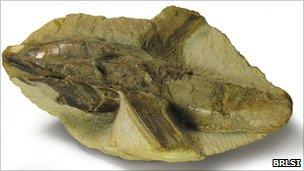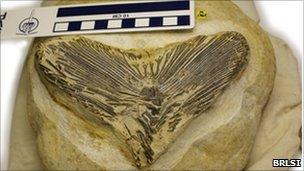Insect fossil discovery at Museum of Somerset
- Published

A restored pachycormus is the earliest known vertebrate dating back to the Jurassic period
Hundreds of insect fossils dating from the Jurassic period have been found at the Museum of Somerset after they were apparently forgotten for nearly 100 years.
Geologist Charles Moore excavated them in the 1800s but they were put in storage in 1915 and never recovered.
They were rediscovered at the museum in Taunton as part of a project to restore Moore's entire fossil collection.
The missing specimens were found by the Bath Royal Literary and Scientific Institution (BRLSI).
It is believed Moore collected up to 1,000 insect specimens although researchers are still making their way through the collection to ascertain the exact number.
The BRLSI received £62,000 in funding from the Esmee Fairbairn Foundation to carry out a three-year research and restoration programme of Moore's collection.
Traces of skin
This has included restoring marine fossils, bringing in scientists from Bristol University to research them and locate the missing part of Moore's collection.
Moore excavated thousands of marine and insect fossils, mainly from Strawberry Bank, a working quarry near Ilminster, as well as from sites around the South West.
The marine fossils from Strawberry Bank are regarded as rare because of the level of detail in the remnants of the muscles, guts and traces of skin.
The researchers have also traced the location of the insect fossils which Moore wrote about in his studies.
Matt Williams, collections manager at BRLSI who is overseeing the project, said: "Their presence at the museum was first noted in the 1980s but no-one had really pursued it.
"Charles Moore had died in 1881 and in 1915 most of his collection of more than 4,000 fossils was bought by BRLSI.
"But part of his collection was given away to the then Somerset Archaeological and Natural History Society and their collection is now housed by the Museum of Somerset and I had heard amongst those specimens might be some from Strawberry Bank.
"These packages haven't been unwrapped since 1915 and some are in wrappings dating back to 1867 so it's quite exciting to unwrap them for the first time - and amongst them I have been discovering unknown Strawberry Bank specimens."
So far they have found winged insects, such as beetles and cockroaches, but are in the process of cataloguing all the specimens before further research can be carried out on them.
Predatory reptiles
As part of the programme, Bristol City Museum preparator Lori Barber also began work last March to restore some of the marine fossils.
So far she has restored 24 of 100 of the fossils which have been chosen for further research by using a special instrument called a micro jack which works in a similar way to an air-powered drill but has a tungsten carbide needle.

A restored fossil showing the caudal fin of a bony fish, probably of the genus Pachycormus
It is used to chip away the rock from the fossils without damaging the fossil itself.
"When the fossils were originally discovered, Charles Moore would have struck them with a hammer and then done some very rough work with a chisel to expose the fossil," said Mr Williams.
Prof Mike Benton, from Bristol University, has been researching the Strawberry Bank marine fossils.
"Ichthyosaurs are a group of swimming predatory marine reptiles and he has discovered there were two rather than one species of ichthyosaurs living in Strawberry Bank," said Mr Williams.
"The papers suggests the site may have represented a shallow place where the ichthyosaurs reared their young."
Prof Benton expects to release more details of his findings later in the year.
- Published5 May 2011
- Published4 May 2011